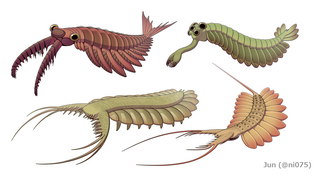
Dinocaridida is a proposed fossil taxon of basal arthropods, which flourished during the Cambrian period and survived up to the Early to Middle Ordovician. The putative Early Devonian member Schinderhannes bartelsi has been considered questionable by some researchers.

Anomalocaris is an extinct genus of radiodont, an order of early-diverging stem-group arthropods.
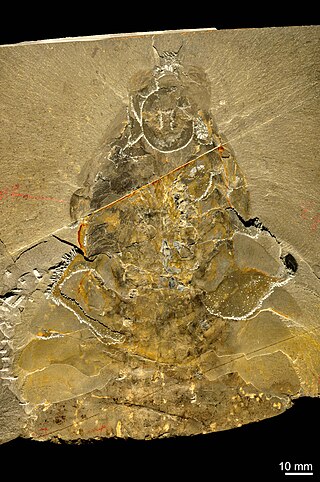
Peytoia is a genus of hurdiid radiodont, an early diverging order of stem-group arthropods, that lived in the Cambrian period, containing two species, Peytoia nathorsti from the Miaolingian of Canada and Peytoia infercambriensis from Poland, dating to Cambrian Stage 3. Its two frontal appendages had long bristle-like spines, it had no fan tail, and its short stalked eyes were behind its large head.

Anomalocarididae is an extinct family of Cambrian radiodonts, a group of stem-group arthropods.

Peytoia infercambriensis is a species of hurdiid radiodont in the genus Peytoia.
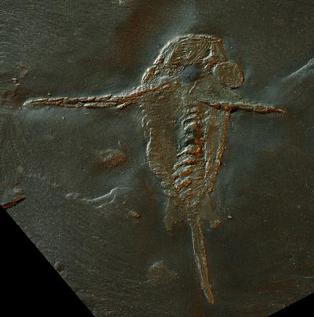
Schinderhannes bartelsi is a species of stem-group arthropod, possibly a hurdiid radiodont (anomalocaridid), known from one specimen from the Lower Devonian Hunsrück Slates. Its discovery was astonishing because the latest definitive radiodonts were known only from the Early Ordovician, at least 66 million years earlier than this taxon. Although some phylogenetic analyses found support for its taxonomic placement as a hurdiid radiodont, other researchers have questioned these assignments.

Radiodonta is an extinct order of stem-group arthropods that was successful worldwide during the Cambrian period. They may be referred to as radiodonts, radiodontans, radiodontids, anomalocarids, or anomalocaridids, although the last two originally refer to the family Anomalocarididae, which previously included all species of this order but is now restricted to only a few species. Radiodonts are distinguished by their distinctive frontal appendages, which are morphologically diverse and used for a variety of functions. Radiodonts included the earliest large predators known, but they also included sediment sifters and filter feeders. Some of the most famous species of radiodonts are the Cambrian taxa Anomalocaris canadensis, Hurdia victoria, Peytoia nathorsti, Titanokorys gainessii, Cambroraster falcatus and Amplectobelua symbrachiata. The latest surviving members include the Aegirocassisinae from the Early Ordovician of Morocco. The putative Early Devonian member Schinderhannes bartelsi from Germany has been considered questionable by some researchers.

Hurdia is an extinct genus of hurdiid radiodont that lived 505 million years ago during the Cambrian Period. Fossils have been found in North America, China and the Czech Republic.

Stanleycaris is an extinct, monotypic genus of hurdiid radiodont from the middle Cambrian (Miaolingian). The type species is Stanleycaris hirpex. Stanleycaris was described from the Stephen Formation near the Stanley Glacier and Burgess Shale locality of Canada, as well as Wheeler Formation of United States. The genus was characterized by the rake-like frontal appendages with robust inner spines.

Caryosyntrips ("nutcracker") is an extinct genus of stem-arthropod which known from Canada, United States and Spain during the middle Cambrian.
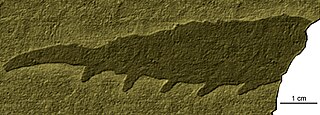
Mureropodia is an animal that existed in what is now the Valdemiedes Formation of Spain during the early Cambrian period. It was described by José Antonio Gámez Vintaned, Eladio Liñán and Andrey Yu. Zhuravlev in 2011, and the type and only species is M. apae.
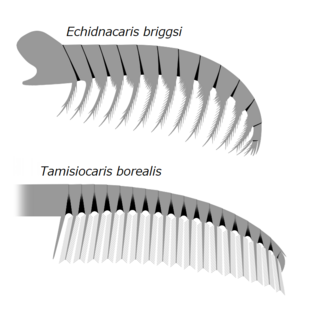
Tamisiocarididae is a family of radiodonts, extinct marine animals related to arthropods, that bore finely-spined appendages that were presumably used in filter-feeding. When first discovered, the clade was named Cetiocaridae after a speculative evolution artwork, Bearded Ceticaris by John Meszaros, that depicted a hypothetical filter-feeding radiodont at a time before any were known to exist. However, the family name was not valid according to the International Code of Zoological Nomenclature, as no real genus named "Cetiocaris" exists, and in 2019 it was formally replaced by the name Tamisiocarididae, after the only valid genus of the clade at the time. The family is only known from Series 2 of the Cambrian, unlike other radiodont families, which persisted longer into the Cambrian. All known species would have lived in tropical or subtropical waters, suggesting a preference for warmer waters.

Amplectobeluidae is a clade of Cambrian radiodonts. It currently includes five definitive genera, Amplectobelua, Lyrarapax, Ramskoeldia, Guanshancaris and a currently unnamed genus from the lower Cambrian aged Sirius Passet site in Greenland. There is also a potential fifth genus, Houcaris, but that genus has become problematic in terms of its taxonomic placement.

Aegirocassis is an extinct genus of giant radiodont arthropod belonging to the family Hurdiidae that lived 480 million years ago during the early Ordovician in the Fezouata Formation of Morocco. It is known by a single species, Aegirocassis benmoulai. Van Roy initiated scientific study of the fossil, the earliest known of a "giant" filter-feeder discovered to date. Aegirocassis is considered to have evolved from early predatory radiodonts. This animal is characterized by its long, forward facing head sclerite, and the endites on its frontal appendages that bore copious amounts of baleen-like auxiliary spines. This animal evolving filter-feeding traits was most likely a result of the Great Ordovician Biodiversification Event, when environmental changes caused a diversification of plankton, which in turn allowed for the evolution of new suspension feeding lifeforms. Alongside the closely related Pseudoangustidontus, an unnamed hurdiid from Wales, the middle Ordovician dinocaridid Mieridduryn, and the Devonian hurdiid Schinderhannes this radiodont is one of the few dinocaridids known from post-Cambrian rocks.

Hurdiidae is an extinct cosmopolitan family of radiodonts, a group of stem-group arthropods, which lived during the Paleozoic Era. It is the most long-lived radiodont clade, with definitive members lasting from the Cambrian to the earliest Ordovician period. The putative Early Devonian member Schinderhannes bartelsi has been considered questionable by some researchers.

Ramskoeldia is a genus of amplectobeluid radiodont described in 2018. It was the second genus of radiodont found to possess gnathobase-like structures and an atypical oral cone after Amplectobelua. The type species, Ramskoeldia platyacantha, was discovered in the Chengjiang biota of China, the home of numerous radiodontids such as Amplectobelua and Lyrarapax.

Ursulinacaris is a genus of hurdiid radiodont from the Cambrian of North America. It contains one known species, Ursulinacaris grallae. It was described in 2019, based on fossils of the frontal appendages discovered in the 1990s and thereafter. The endites of Ursulinacaris were very slender, unlike other hurdiids such as Peytoia or Hurdia. It was initially reported as the first hurdiid with paired endites, but Moysiuk & Caron (2021) suggested that it is actually the preservation of the fossils and thus no paired endites.

Houcaris is a possibly paraphyletic radiodont genus, tentatively assigned to either Amplectobeluidae, Anomalocarididae or Tamisiocarididae, known from Cambrian Series 2 of China and the United States. The type species is Houcaris saron which was originally described as a species of the related genus Anomalocaris. Other possible species include H. magnabasis and H. consimilis. The genus Houcaris was established for the two species in 2021 and honors Hou Xianguang, who had discovered and named the type species Anomalocaris saron in 1995 along with his colleagues Jan Bergström and Per E. Ahlberg.

Laminacaris is a genus of extinct stem-group arthropods (Radiodonta) that lived during the Cambrian period. It is monotypic with a single species Laminacaris chimera, the fossil of which was described from the Chengjiang biota of China in 2018. Around the same time, two specimens that were similar or of the same species were discovered at the Kinzers Formation in Pennsylvania, USA. The first specimens from China were three frontal appendages, without the other body parts.
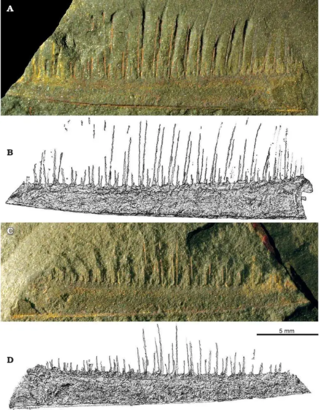
Pseudoangustidontus is a genus of hurdiid (peytoiid) radiodont from the Lower Ordovician of Morocco. This genus is known from two described species, P. duplospineus and P. izidigua, with some specimens that are hard to determine which species to belong to. This animal is only known from the Fezouata Formation, a fossil site in Morocco that is of Lagerstätte status, meaning that the fossils from this site are exceptionally preserved. Because of its partial remains, its classification was debated, but with more complete fossils it is identified as radiodont frontal appendage.





















